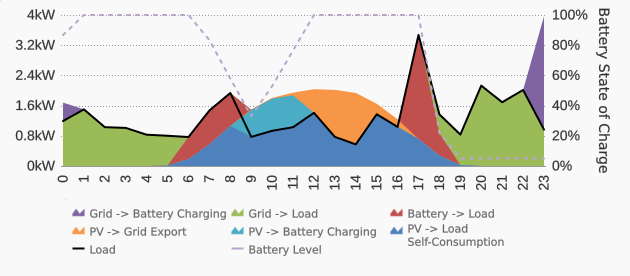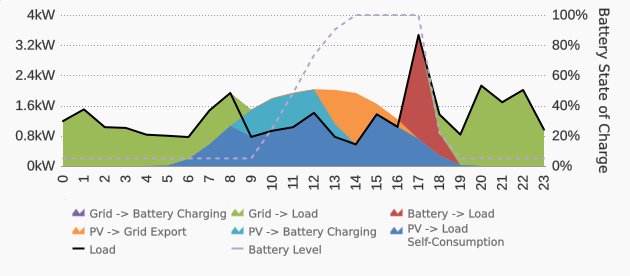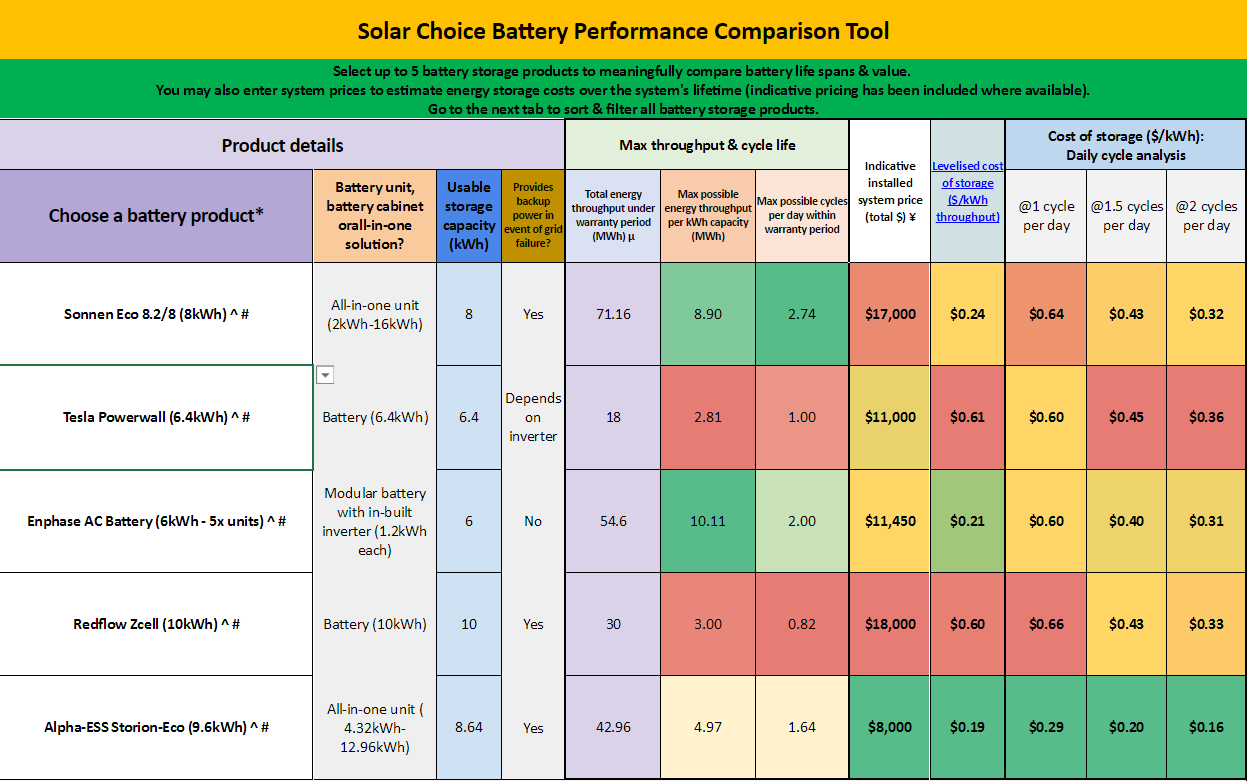There are a lot of different ways to potentially get value out of a home battery storage system. Something that not many storage system shoppers realises is that it is possible to charge/discharge (or ‘cycle’) your batteries more than once a day. In fact, in the right circumstances, cycling your batteries more than once a day can potentially help to significantly reduce your energy bills and shorten the payback period of your battery storage system. This article takes a look at battery cycling regimes and how they can impact the economics and longevity of a battery storage system.
Solar charging, grid charging – or both?
Two of the main uses for batteries are storing solar energy and tariff arbitrage. We’ve explained the implications of both of these for daily battery cycling below.
Solar charging is the most obvious use for batteries in residential situations. As the term implies, solar charging is when you use your solar PV system to charge up your battery bank. Most of the time this will happen when you are out during the day (for example, at work) and when your solar energy might otherwise be ‘wasted‘. For most homes, solar energy is worth more to you when used directly (‘self-consumption‘) than when exported to the grid (a solar feed-in tariff), where it will earn you only a small energy bill credit. This is why many people consider installing batteries in the first place. If your battery storage system only does solar charging, your battery will cycle at most once per day.
Example energy flow chart illustrating battery charge/discharge on a solar-only charging regime. You can see the battery reach full capacity (dotted line) on the back of the home’s excess solar energy production before being discharged to meet the home’s evening peak. This is one full cycle of the battery. (Image created using PVSell.)
Tariff arbitrage is when you charge your battery using cheap, off-peak grid electricity in order to later discharge it during peak pricing times, when grid electricity is expensive. In order to do tariff arbitrage, you must a) be signed up for a time-of-use billing plan, and b) have a battery storage system that can charge from the grid (not all have this functionality). The difference between peak and off-peak rates can be as large as 30c per kilowatt-hour (kWh), making it an effective way to save on household energy costs. Although you could theoretically just install batteries on their own (without solar) to do tariff arbitrage, it would be much more cost-effective to install a solar system instead (if you’re going to choose between one or the other). The sweet spot for tariff arbitrage to happen is on the back of solar charging, so that in total your batteries are cycled up to twice daily – once with the sun and once with the grid.

An example energy flow chart illustrating battery charge/discharge with solar and off-peak grid charging. As you can see (dotted line), the battery reaches full charge two times during the day, delivering nearly twice as much energy to the home as in a solar-only charging situation. With price differentials as high as 30c/kWh on time-of-use billing, tariff arbitrage can help to significantly shorten battery storage system payback times. (Image created using PVSell.)
Remember: You’re likely get the most value of a grid-connected battery storage system by undersizing it (as we’ve written before). A smaller battery bank is more likely to be fully utilised – which is key in ensuring the shortest possible payback period and best returns.
What are the implications of multiple cycles per day for batteries?
We’ve recently been looking into the topic of daily multi-cycling of batteries in detail. Both our Battery Storage Sizing & Payback Estimator Tool and SunWiz’s PVSell software show that cycling batteries more than once a day can save the system owner more money than cycling only once per day with solar.
Additionally, Solar Choice’s Battery Storage Product Performance Comparison Tool estimates the levelised cost of storage (LCOS) in 1x, 1.5x and 2x daily cycling scenarios (example in the table below). It only takes simple maths to show that the cost of each kWh of energy stored over the battery’s lifetime (‘lifetime energy throughput’) decreases with the number of times the battery is cycled per day.
Nevertheless, it’s likely that most homes that get battery storage will go the solar-only charging route. There are two main reasons for this: solar-only charging is easier to understand and means a greater reliance on clean, self-generated energy. Despite its financial promise, tariff arbitrage muddies the waters on this front a little bit; coal-heavy grid electricity is certainly not ‘green’, and a high degree of energy self-reliance is the closest that most Australian homes will get to living the off-grid dream.
There are also a number of things to keep in mind from a more technical perspective when it comes to 2x daily charging. We’ve outlined them below.
- Twice daily cycling looks great on paper, but in practice it may not happen every day. Some days your morning energy consumption may not be as large as other days, so you will not drain down your battery fully in order for it to then be re-filled by solar. So if you’re basing your estimated payback period on a 2x/day cycling regime, you’d do yourself a favour to swap it out with an estimate based on a more conservative 1.5x/day cycling regime instead.
- You may not be able take advantage of the full peak/off-peak price differential. This will depend on you’re battery’s starting state of charge, the expected weather for the day, your energy consumption pattern for the day and your TOU schedule. Consider, for example, the possibility that you could charge with off-peak energy in the wee hours of the morning only to shortly thereafter discharge during shoulder rate periods to meet late morning demand. Depending on your plan, the price differential could be as small as 10c/kWh. If this happens a lot, your payback period will be significantly lower than the rosiest 2x/day cycle, peak/off-peak differential scenario.
- Cycling more than once a day may void your battery’s warranty or shorten its life. Not all battery banks are designed (or warrantied) to be cycled more than once a day, and some only allow for solar charging. Ask the installers who you’ve received quotes from whether multiple cycles per day will be possible with their battery bank product. There are plenty of products that will do this without a problem, but you need to be sure.
- Your batteries may not be able to charge/discharge fast enough to keep up with your energy use. Different batteries have different specifications for charge & discharge rates; basically, this means that a battery bank can only charge/discharge a certain mount of electricity at a given moment. A good analogy is that these rates are like straws – the bigger the straw (i.e. the higher the charge/discharge rate), the more power can get through at once. If the power output rating is low, you may not be able to fully discharge the battery bank, and it may not meet all of your electricity requirements when your demand ‘spikes’ in the evening (when most households tend to have multiple devices switched on at once). While this doesn’t mean that your power will go out (the grid will contribute what your battery can’t meet), it will potentially mean a longer payback period for you. A reputable installer will explain this to you and let you know the limitations of your system.
In summary…
In the right circumstances, using grid-charging to cycle your batteries more than once a day could make a big difference for the payback period of a battery bank. However, it’s key to keep in mind the limitations of doing so – and know whether the products you’re considering are capable of charging more than once daily. Hopefully this article clears the air about this potentially tricky topic.
Ready to shop for solar & batteries? Compare solar & battery quotes from installers in your area.
© 2016 Solar Choice Pty Ltd
- Why a big battery could be cheaper than a small battery with the federal rebate? - 19 June, 2025
- Heat Pump Costs – Solar Choice Price Index - 1 June, 2025
- Solar Panel Costs: Solar Choice Price Index | July 2025 - 1 June, 2025


We were recommending our customers to use grid-charging to cycle their batteries more than once a day. But we agree with you that the charging capacity is an important aspect which can’t be ignored. Thanks for this information.